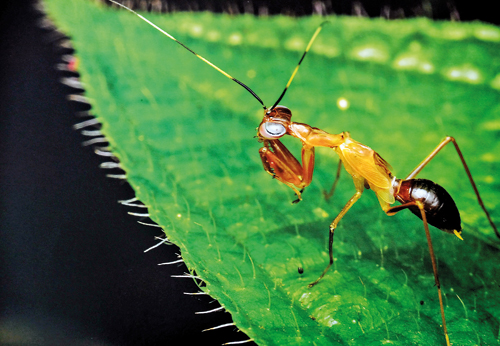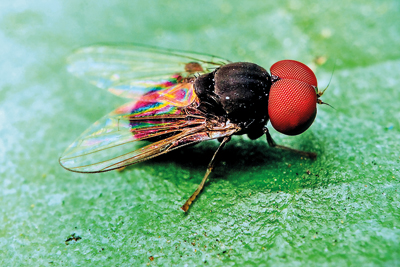Lots about those little insects
View(s): “Splendid!” was my first reaction as I opened the parcel bearing my review copy. And a thorough look at the book has only supported that view.
“Splendid!” was my first reaction as I opened the parcel bearing my review copy. And a thorough look at the book has only supported that view.
The forces behind this book, Nalini and Tom Ellawela, commenced a project to return an abandoned rubber plantation to its original state as a wet zone forest. Over the years they established an educational centre, and hosted many student groups and other visitors. One of them, Roman Prokhorov, was a Ukrainian photographer who was interested in insects. He showed Nalini and Tom his photos and they were captivated by their beauty and decided to share Roman’s photos in a book. They recognised the need for a narrative to go along with the photos and wanted to produce a book that would not only educate but also inspire. They enlisted Dr. Jayanthi Edirisinghe and Dr.Inoka Karunaratne, both professors of entomology at the University of Peradeniya,with the task of completing the text, and Dr. Sriyanie Miththapala for her expertise in enhancing and editing the text to bring the stories alive.
The foreword by Nalini Ellawela discusses the genesis of the reforestation project and the impetus to write the book, which was to highlight the pressing need to create awareness of the importance of insects in the biosphere. The material that follows is presented within sections of families of insects with the first section being designated to provide an overall description of insect structure, diversity, biology, ecology, life cycles and most importantly, their economic importance and the important role they play in the complex web of life.
The narratives of insects commence with dragonflies and damselflies with a beautiful image of a Marsh Skimmer in resting posture and the narrative highlights the importance of dragonflies as bio-indicators of water quality. There are six photos of dragonflies, each identified with its scientific and common name, including a stunning close-up of a dragonfly head and wings showing the huge compound eyes and the muscular powerhouse which assists in acrobatic flights. Given the very large numbers of insect species found it is to be expected that only representative samples are depicted in this book.
The next two sections are on cockroaches, wood roaches and termites with an informative discussion and exquisite photos of these unappreciated insects. Their importance in the recycling of nutrients is described but the tremendous damage that some termites inflict on human dwellings is also highlighted.The section on the mantids has some excellent close-up photographs that clearly show their deadly apparatus for capturing their insect prey, and how beautifully camouflaged some species are. Mantids are infamous for their mating habits in which the female decapitates and eats the male just after mating has occurred. Rocking behaviour is described in which the mantid mimics a leaf or stick swaying in the wind.
 The earwigs are discussed next highlighting their distinctive structures including their forceps-like pincers. Among the grasshoppers are the bizarre images of the monkey-grasshopper which defies earthly description! Fourteen images of grasshoppers, crickets and locusts are included to indicate the high diversity of this group at Mahausakande.Leaf hoppers, cicadas, tree hoppers, frog hoppers, plant hoppers and their relatives and their relationship with plants as sap-feeding insects is discussed at length, highlighting their importance in maintaining balance in the ecosystem with interesting comments such as on their ability to jump very long distances compared to their size.Of the 794 species of true bugs identified in Sri Lanka, eight are illustrated in the book, each belonging to a different ecological niche with different feeding habits.
The earwigs are discussed next highlighting their distinctive structures including their forceps-like pincers. Among the grasshoppers are the bizarre images of the monkey-grasshopper which defies earthly description! Fourteen images of grasshoppers, crickets and locusts are included to indicate the high diversity of this group at Mahausakande.Leaf hoppers, cicadas, tree hoppers, frog hoppers, plant hoppers and their relatives and their relationship with plants as sap-feeding insects is discussed at length, highlighting their importance in maintaining balance in the ecosystem with interesting comments such as on their ability to jump very long distances compared to their size.Of the 794 species of true bugs identified in Sri Lanka, eight are illustrated in the book, each belonging to a different ecological niche with different feeding habits.
The extraordinary diversity of beetles is illustrated with 28 stunning images; the importance of beetles as predators controlling populations of mealybugs, aphids and scale insects are highlighted though there are no photos of them actually eating them; a tiger beetle with its formidable set of jaws for killing other insects is amply illustrated in great detail in one of the images.
The text describes in detail the importance of beetles in the regenerating forest of Mahausakande. Some images of beetles that are not weevils have been inadvertently included under the Weevils subheading, but nevertheless add to the pictorial representation of the diversity of beetles at Mahausakanda. Flies, mosquitoes and midges (Order Diptera) are presented with some very interesting statistics: there are 1341 species of Dipterans in Sri Lanka of which 139 are mosquitoes with discoveries of new species continuing to be made.There is an interesting narrative of mimicry with images of the models and their mimics.
One defining feature of the Flies is the presence of halteres, which are modified wings that act as balancing organs: these are beautifully captured in many of these images. Four species of butterflies and 19 species of moth are shown, and the text highlights the destructive impact of human activities on the food sources of butterflies and moths in their larval and adult stages, and the efforts made to bring back these insects to the Mahausakande forest.
The last section describes the social insects, ants and bees, with interesting images of mating behaviours; the importance of these insects as pollinators, and their important role in the economy is highlighted. The book ends with a basic glossary, a note from the authors and a note about the editor.
Despite the limited scope within which the book was written, it captures the essence of the insect fauna of the regenerating forest with wonderful images and well-researched content. Those of a scientific bent may wonder why many of the images do not have names attributed to them, but the authors point out that proper identification often requires close examination of specimens in the hand, especially those that look similar superficially. All of the insects illustrated, however, are identified as to the major group of insects to which they belong and many to their sub-groupings.
The text is highly readable and written with the average person in mind with a fine balance of technical and non-technical jargon to weave a story of their interesting lives.
As a photographer, I kept asking myself how Roman took these spectacular photos! Though a list of the equipment that Roman used is given, photographers like myself would have appreciated more technical details. But it has inspired me to take a closer look at the many insects all around me as I travel.
Although targeted to a general audience, this book provides substantial scientific content, easily understood by the general reader and is highly educational. Needless to say, the authors have fulfilled their objective in writing this book which was to create awareness about insects, their lives and their value to humans in the hope that at least part of the negative press that insects receive is redressed. In addition, the images highlight the beauty, albeit bizarre at times, of these magnificent and unappreciated insects. A lovely book to enlighten the casual reader as well as those interested in the insects of the wet zone forests of Sri Lanka.
| Book facts | |
| Insects: The hidden treasures of Mahauskande- by Jayanthi Edirisinghe, Inoka Karunaratne and Roman Prokhorov. Edited by Sriyanie Miththapala. Reviewed by Dr. Michael van der Poorten Price: Rs. 9, 500 Available at the head office of the Ellawela Foundation Trust, No. 14, |


